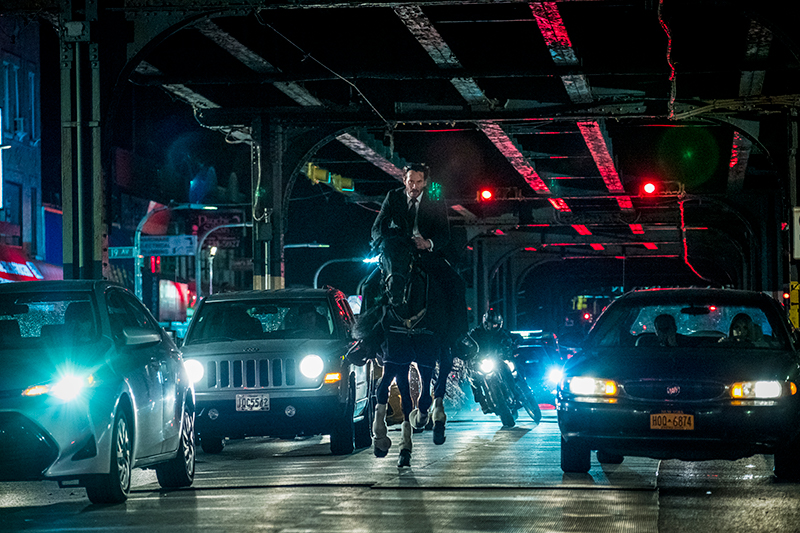John Wick: Chapter 3 – Parabellum

Keanu Reeves stars as John Wick in JOHN WICK: CHAPTER 3 - PARABELLUM. Photo by: Niko Tavernise

A knife fight in the first act so excessively violent it borders on parody reminds me of a scene in the action/comedy KUNG FU HUSTLE. In the latter, Stephen Chow tries to hurl steak knives at a cigarette-dragging landlady, which invariably ricochet back into him. In both cases, we’re catching our breath from the dizzying array of swords, axes and other sharp objects, that teeters on the edge of slapstick comedy.
The writers (all four of them), and director Chad Stahelski (a former stuntman who doubled for Keanu Reeves in THE MATRIX), have wrung out nothing particularly interesting here in terms of story. Like the flawed MATRIX sequels, the JOHN WICK series starts with a narrowly defined idea (a confined revenge drama between two classes of criminal), and expands it to absurdity. In Chapter Two, we learn about the mysterious organization under the High Table—overseen by Winston (Ian McShane), who allows John to break certain rules. In Chapter Three, this puts John on the wrong side of the High Table and the man who stands above it.
Played by Said Taghmaoui, The Elder is, of course, an infinitely wealthy Middle Easterner who lives in the middle of nowhere. I suppose that’s the only safe haven from a world in which anyone who moves and/or breathes is an undercover assassin. Now, ask yourself: what good are rules and organizations if someone can arbitrarily decide who can skirt or ignore them? Aside from the impersonal video game aesthetics of the gunfights, and the fact that Halle Berry pops off at least forty bullets from a pistol without once reloading, the plot turns on the ability of key characters to negotiate at the last minute—again and again. Sure, people do make deals, have back channel conversations, break conventions. We do it all the time. It’s called life. But that undermines the notion of having an organization whose entire thing is civilized vigilantism. But if everybody can break the rules, then they’re not really rules. So then why does John have a bounty on his head in the first place?
Save for an inspired, acrobatic sequence involving two dogs and a handful of very skilled stunt people, most of the mindless violence rises to the level of absurdity of video game logic. Fights are never sloppy until someone needs to die, guns run out of bullets only when someone needs to die, and characters come back into the action at the exact moment the plot needs the other guy to die despite having painted itself into a corner.
It’s still entertaining watching some of the work. We know it’s wire-fu and effects, but there’s a level of stunt-driven action that makes it feel like Cirque du Soleil on stilts, chased by a pack of wolves. Stahelski knows exactly what this film is. We know exactly what this film is. We know that it’s entertaining in parts. But is that all there is? There’s no arguing that The Table involves some elaborate world building with its peripheral characters, including the Adjudicator (Asia Kate Dillon), the Bowery King (Laurence Fishburne), and the hilariously uncool villain, Zero (Mark Dacascos taking notes from Jason Statham’s self-parody in SPY) but I can’t credit this film with something left for the next installment to finish.